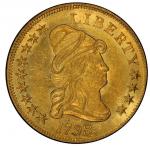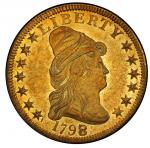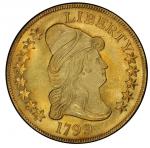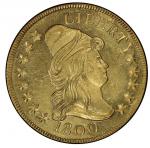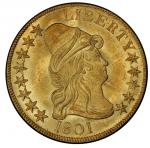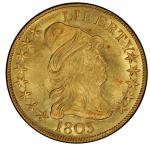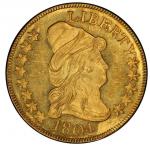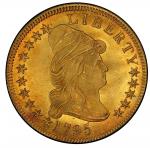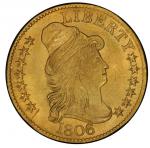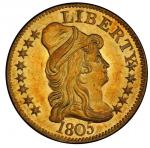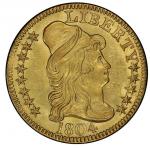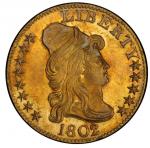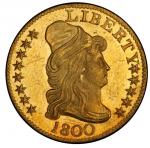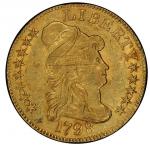You seem to be fully convinced of the propriety of attending to beauty in coinage ... [Jean-Pierre Droz] is much in favor of the idea of representing an eagle on the coins & particularly the large gold piece. This bird all the artists consider as the most proper for presenting a fine form. For that purpose however it would be necessary to remove those heraldic parts which cover the body in the arms of the U.S. — William Short to Alexander Hamilton, August 23, 1791.This is an especially lively specimen of the last Small Eagle $10 gold piece. Coppery toning with hints of violet gathers at the peripheries of both sides, embracing highly lustrous deep yellow gold surfaces. The cartwheel luster is strong on both sides, most profound just inside the rims. A layer of hairlines is visible on both sides, accounting for the grade as assigned, but the visual appeal well exceeds the numerical grade. Very few marks of consequence are noted, even under a glass. A thin line extends from the bust truncation past the tip of Libertys nose to under ER of LIBERTY, and a few minor scratches gather left of the second A in AMERICA. Despite the lines, a fine original look remains intact, and the detail far surpasses that seen on most survivors from this rare die marriage.Light adjustment marks are noted at the central obverse, mostly running together though strands criss-cross behind the corner of Libertys eye. Shallower vestiges of adjustment are visible throughout the fields, joined by scattered light planchet chips that are most evident behind Libertys head. An impressive die crack from the rim below star 16 toward Libertys throat catches the eye immediately, but other fainter die cracks are only found with a glass. One connects the crack from star 16 to the tip of Libertys bust, another delicately strings along the tops of LIB in LIBERTY, and a vertically oriented crack begins at star 16 before disappearing into the field above. A short crack closes the open top of the reverse wreath, mostly hidden among the leaves. The hollow leaf at the left top of the wreath and some fine lines on the lower right serif of E in STATES suggests some light lapping in this area.Following the 1795 and 1796 issues, this is the very last of the Small Eagle $10s and, as David Akers noted in 1980, "it is decidedly the rarest of the three." Historians may never know what inspired the fairly scrawny interpretation of an eagle gripping a wreath in its beak, but it was replaced after just two years with an eagle that closely resembled the one found on the Great Seal, complete with 13 stars above its head and the motto E PLURIBUS UNUM. Thomas Jeffersons longtime secretary, William Short, was in Paris when he wrote to Alexander Hamilton in 1791, reporting that the Swiss-born engraver and engineer Jean-Pierre Droz was interested in designing the future coins of the United States Mint. Jefferson had met Droz in Paris in 1786 and been impressed with his novel coining press, but Drozs continued flirtations with the Americans may be viewed with two centuries of hindsight primarily as leverage in his relationship with his once and future boss, Matthew Boulton of Birmingham, England. Jeffersons affection for Drozs ideas was strong enough to make us wonder today if the preference for a Small Eagle design versus a Heraldic Eagle design was his own, echoing the thoughts that Droz had espoused to Short, one of his closest friends, a few years earlier.All 1797 eagles with the Small Eagle design were coined from a single set of dies. The mintage was tiny, widely publicized as 3,615 pieces but estimated at a lower range of 1,250 to 3,615 in the Bass-Dannreuther book. Of the 60 or so that have survived to the present day, most show significant handling, and coins with strong visual appeal are very rare. PCGS has certified two Mint State specimens, this being the lone finest certified.


